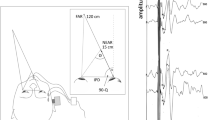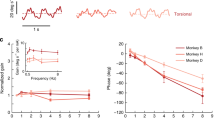Abstract
Vergence is one of several viewing contexts that require an increase in the angular vestibular-ocular reflex (aVOR) response. A previous monkey study found that the vergence-mediated gain (eye/head velocity) increase of the aVOR was attenuated by 64 % when anodic currents, which preferentially lower the activity of irregularly firing vestibular afferents, were delivered to both labyrinths. We sought to determine whether there was similar evidence implicating a role for irregular afferents in the vergence-mediated gain increase of the human aVOR. Our study is based upon analysis of the aVOR evoked by head rotations, delivered passively while subjects viewed a near (15 cm) or far (124 cm) target and applying galvanic vestibular stimulation (GVS) via surface electrodes. We tested 12 subjects during 2–3 sessions each. Vestibular stimuli consisted of passive whole-body rotations (sinusoids from 0.05–3 Hz and 12–25°/s, and transients with peak ~15°, 50°/s, 500°/s2) and head-on-body impulses (peak ~30°, 150°/s, 3,000°/s2). GVS was on for 10 s every 20 s. All polarity combinations were tested, with emphasis on uni- and bi-lateral anodic inhibition. The average stimulus current was 5.9 ± 1.6 mA (range: 3–9.5 mA), vergence angle (during near viewing) was 22.6 ± 2.8° and slow-phase eye velocity caused by left anodic current stimulation with head stationary was −3.4 ± 1.1°/s, −0.2 ± 0.6°/s and 2.5 ± 1.4°/s (torsion, vertical, horizontal). No statistically significant GVS effects were observed, suggesting that surface electrode GVS has no effect on the vergence-mediated gain increase of the aVOR at the current levels (~6 mA) tolerated by most humans. We conclude that clinically practical transmastoid GVS does not effectively silence irregular afferents and hypothesize that currents >10 mA are needed to reproduce the monkey results.





Similar content being viewed by others
References
Aw ST, Haslwanter T, Halmagyi GM, Curthoys IS, Yavor RA, Todd MJ (1996) Three-dimensional vector analysis of the human vestibuloocular reflex in response to high-acceleration head rotations. I. Responses in normal subjects. J Neurophysiol 76:4009–4020
Aw ST, Todd MJ, Halmagyi GM (2006) Latency and initiation of the human vestibuloocular reflex to pulsed galvanic stimulation. J Neurophysiol 96:925–930
Bacsi AM, Colebatch JG (2003) Anodal vestibular stimulation does not suppress vestibular reflexes in human subjects. Exp Brain Res 150:525–528
Breson K, Elberling C, Fangel J (1971) Galvanic nystagmography. Acta Otolaryngol 71:449–455
Carl JR, Gellman RS (1987) Human smooth pursuit: stimulus-dependent responses. J Neurophysiol 57:1446–1463
Chen-Huang C, McCrea RA (1998) Contribution of vestibular nerve irregular afferents to viewing distance-related changes in the vestibulo-ocular reflex. Exp Brain Res 119:116–130
Chen-Huang C, McCrea RA, Goldberg JM (1997) Contributions of regularly and irregularly discharging vestibular-nerve inputs to the discharge of central vestibular neurons in the alert squirrel monkey. Exp Brain Res 114:405–422
Clendaniel RA, Lasker DM, Minor LB (2001) Horizontal vestibuloocular reflex evoked by high-acceleration rotations in the squirrel monkey. IV. Responses after spectacle-induced adaptation. J Neurophysiol 86:1594–1611
Day BL, Séverac Cauquil A, Bartolomei L, Pastor MA, Lyon IN (1997) Human body-segment tilts induced by galvanic stimulation: a vestibularly driven balance protection mechanism. J Physiol 500:661–672
De Waele C, Meguenni R, Freyss G, Zamith F, Bellalimat N, Vidal PP, Tran Ba Huy P (2002) Intratympanic gentamicin injections for Meniere disease: vestibular hair cell impairment and regeneration. Neurology 59:1442–1444
Diggle PJ, Liang KY, Zeger SL (1994) Analysis of longitudinal data. Oxford University Press, New York
Ezure K, Cohen MS, Wilson VJ (1983) Response of cat semicircular canal afferents to sinusoidal polarizing currents: implications for input-output properties of second-order neurons. J Neurophysiol 49:639–648
Fitzpatrick RC, Day BL (2004) Probing the human vestibular system with galvanic stimulation. J Appl Physiol 96:2301–2316
Fitzpatrick R, Burke D, Gandevia SC (1994) Task-dependent reflex responses and movement illusions evoked by galvanic vestibular stimulation in standing humans. J Physiol 478:363–372
Goldberg JM (2000) Afferent diversity and the organization of central vestib-ular pathways. Exp Brain Res 130:277–297
Goldberg JM, Smith CE, Fernandez C (1984) Relation between discharge regularity and responses to externally applied galvanic currents in vestibular nerve afferents of the squirrel monkey. J Neurophysiol 51:1236–1256
Halmagyi GM, Curthoys IS, Cremer PD, Henderson CJ, Todd MJ, Staples MJ, D’Cruz DM (1990) The human horizontal vestibulo-ocular reflex in response to high-acceleration stimulation before and after unilateral vestibular neurectomy. Exp Brain Res 81:479–490
Haslwanter T (1995) Mathematics of three-dimensional eye rotations. Vis Res 35:1727–1739
Hepp K (1990) On listing’s law. Commun Math Phys 132:285–295
Hullar TE, Della Santina CC, Hirvonen T, Lasker DM, Carey JP, Minor LB (2005) Responses of irregularly discharging chinchilla semicircular canal vestibular-nerve afferents during high-frequency head rotations. J Neurophysiol 93:2777–2786
Hullar TE, Minor LB (1999) High-frequency dynamics of regularly discharging canal afferents provide a linear signal for angular vestibuloocular reflexes. J Neurophysiol 82:2000–2005
Karlberg M, McGarvie L, Magnusson M, Aw ST, Halmagyi GM (2000) The effects of galvanic stimulation on the human vestibulo-ocular reflex. NeuroReport 11:3897–3901
Kim J, Curthoys IS (2004) Responses of primary vestibular neurons to galvanic vestibular stimulation (GVS) in the anaesthetised guinea pig. Brain Res Bull 64:265–271
Kleine JF, Guldin WO, Clarke AH (1999) Variable otolith contribution to the galvanically induced vestibulo-ocular reflex. NeuroReport 10:1143–1148
Lasker DM, Ramat S, Carey JP, Minor LB (2002) Vergence-mediated modulation of the human horizontal angular VOR provides evidence of pathway-specific changes in VOR dynamics. Ann N Y Acad Sci 956:324–337
MacDougall HG, Brizuela AE, Burgess AM, Curthoys IS (2002) Between-subject variability and within-subject reliability of the human eye-movement response to bilateral galvanic (DC) vestibular stimulation. Exp Brain Res 144:69–78
MacDougall HG, Brizuela AE, Curthoys IS (2003) Linearity, symmetry and additivity of the human eye-movement response to maintained unilateral and bilateral surface galvanic (DC) vestibular stimulation. Exp Brain Res 148:166–175
Magnusson M, Johansson R, Wiklund J (1990) Galvanically induced body sway in the anterior-posterior plane. Acta Otolaryngol 110:11–17
McConville KM, Tomlinson RD, Na EQ (1996) Behavior of eye-movement-related cells in the vestibular nuclei during combined rotational and translational stimuli. J Neurophysiol 76:3136–3148
Migliaccio AA, Todd MJ (1999) Real-time rotation vectors. Australas Phys Eng Sci Med 22:73–80
Migliaccio AA, Minor LB, Carey JP (2004) Vergence-mediated modulation of the human horizontal vestibulo-ocular reflex is eliminated by a partial peripheral gentamicin lesion. Exp Brain Res 159:92–98
Migliaccio AA, Minor LB, Carey JP (2008) Vergence-mediated modulation of the human angular vestibulo-ocular reflex is unaffected by canal plugging. Exp Brain Res 186:581–587
Minor LB (1999) Intratympanic gentamicin for control of vertigo in Meniere’s disease: vestibular signs that specify completion of therapy. Am J Otol 20:209–219
Paige GD, Tomko DL (1991) Eye movement responses to linear head motion in the squirrel monkey. I. Basic characteristics. J Neurophysiol 65:1170–1182
Quarck G, Etard O, Normand H, Pottier M, Denise P (1998) Low intensity galvanic vestibulo-ocular reflex in normal subjects. Neurophysiol Clin 28:413–422
Schneider E, Glasauer S, Dieterich M (2002) Comparison of human ocular torsion patterns during natural and galvanic vestibular stimulation. J Neurophysiol 87:2064–2073
Snyder LH, King WM (1992) Effect of viewing distance and location of the axis of head rotation on the monkey’s vestibuloocular reflex. I. Eye movement responses. J Neurophysiol 67:861–874
Straumann D, Zee DS, Solomon D, Lasker AG, Roberts DC (1995) Transient torsion during and after saccades. Vision Res 35:3321–3334
Tychsen L, Lisberger SG (1986) Visual motion processing for the initiation of smooth-pursuit eye movements in humans. J Neurophysiol 56:953–968
Viirre E, Tweed D, Milner K, Vilis T (1986) A reexamination of the gain of the vestibuloocular reflex. J Neurophysiol 56:439–450
Watson SRD, Colebatch JG (1997) EMG responses in the soleus muscles evoked by unipolar galvanic vestibular activation. Electroencephalogr Clin Neurophysiol 105:476–483
Watson SRD, Colebatch JG (1998) Vestibular-evoked EMG responses in soleus: a comparison between click and galvanic stimulation. Exp Brain Res 119:504–510
Watson SR, Brizuela AE, Curthoys IS, Colebatch JG, MacDougall HG, Halmagyi GM (1998) Maintained ocular torsion produced by bilateral and unilateral galvanic (DC) vestibular stimulation in humans. Exp Brain Res 122:453–458
Zink R, Bucher SF, Weiss A, Brandt T, Dieterich M (1998) Effects of galvanic vestibular stimulation on otolithic and semicircular canal eye movements and perceived vertical. Electroencephalogr Clin Neurophysiol 107:200–205
Acknowledgments
A.A. Migliaccio was supported by an NHRMRC (Australia) Biomedical CDA 568736 grant and a NIH/NIDCD (USA) R03 DC007346 grant. C.C Della Santina and J.P. Carey were supported by NIH/NIDCD grants RO1 DC009255 and R01 DC05040, respectively.
Author information
Authors and Affiliations
Corresponding author
Rights and permissions
About this article
Cite this article
Migliaccio, A.A., Della Santina, C.C. & Carey, J.P. Transmastoid galvanic stimulation does not affect the vergence-mediated gain increase of the human angular vestibulo-ocular reflex. Exp Brain Res 224, 489–499 (2013). https://doi.org/10.1007/s00221-012-3330-2
Received:
Accepted:
Published:
Issue Date:
DOI: https://doi.org/10.1007/s00221-012-3330-2




